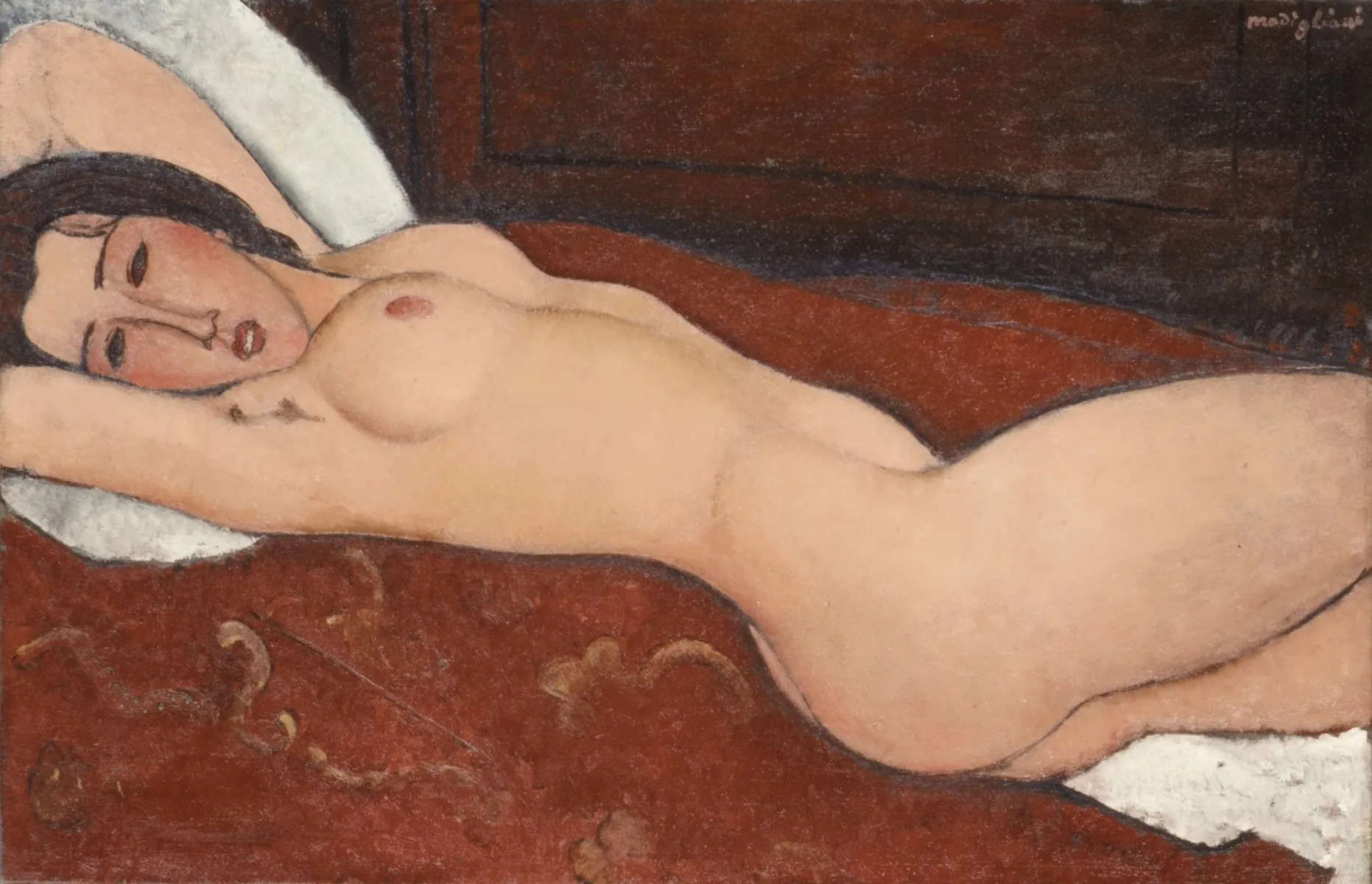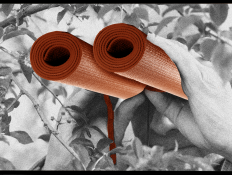
Live fast, die young, and leave behind a beautiful corpse. Such is the legend of Italian 20th-century artist Amedeo Modigliani. If you generously mark the start of his career at age 14, when he first took art classes, this painter and sculptor was active for just two decades before dying of tubercular meningitis at age 35. But in that time, Modi (as his friends called him) brought a singular vision to his portraits and nudes.
Part of what made his work so distinctive was his personal amalgam of old-school styles from his native Italy, such as a rust-heavy color palette and Mannerist elongations, with the modernism of his time. “He was essentially a traditionalist,” wrote James Thrall Soby in the catalog for Modigliani’s 1951 solo exhibition at the Museum of Modern Art, “who happened to have caught fire from the excitement of a contemporary idiom.”
In his portraits, Modigliani’s subject of choice, sitters are granted a degree of stylization that withholds clues about their station in life. Everyone, from wealthy doctors to the local barmaid, looks both highly individual and yet, at the same time, monumental.
“I was astonished once when Modigliani found someone—a conspicuously ugly person—beautiful,” Russian poet Anna Akhmatova, with whom Modigliani had a relationship around 1910, wrote in her memoir. “He insisted on it. It came to me then that he must see things completely differently than we did.”
Serene as his canvases were, in real life Modigliani was erratic and habitually broke. An alcoholic (who may have also been addicted to hashish), he nonetheless maintained an aristocratic air. And so, even after he died in a pauper’s hospital, a princely funeral procession escorted him to his final resting place at Père Lachaise cemetery in Paris.
-
Early life

Image Credit: Jewish Chronicle/Heritage Images/Getty Images. Born in 1884 in the Tuscan port city of Livorno, Amedeo was the youngest child of Eugenia and Flaminio Modigliani, an Italian Jewish couple who nicknamed him Dedo. He was close to his mother, who worked as a translator and director of a school and encouraged his artistic path. It was her brother, Amédée (the artist’s namesake), who financially supported Modigliani’s earliest studies, paying for his drawing classes at the studio of Guglielmo Micheli from 1898 to 1900. Micheli was a landscape and seascape painter who had trained under one of the founders of the Italian Macchiaioli school—an unusual start for Modigliani, who would rarely paint landscapes later on.
The young artist had to stop these studies abruptly in 1900 when he contracted tuberculosis. After he received ineffective treatment at a local clinic, his mother took him to southern Italy, where she believed the sun exposure would help him. While they were in the region, they toured Capri, Amalfi, and Naples. Working their way north, the two then visited Rome, Florence, and Venice, visiting churches, museums, and galleries.
After Modigliani recovered his health, his uncle continued to support him, helping him pay for classes at the Florentine Scuola Libera del Nudo in 1901. He lived and worked in Florence in 1902 and 1903, then spent most of the next three years in Venice, where he attended classes at the Accademia di Belle Arti. While in Venice he befriended artist Manuel Ortiz de Zárate, who told him tales about life in Paris and sparked Modigliani’s interest in living there.
-
Move to Paris

Image Credit: Private collection. Digital image via Getty Images. Generous Uncle Amédée died in 1905, and it was likely with some inheritance money that Modigliani moved to Paris in January 1906. Among his many Parisian addresses, he lived at first at a hotel near La Madeleine and became a regular at Chez Rosalie, a restaurant in Montparnasse whose proprietor, fellow Italian Rosalie Tobia, took pity on the artist and often accepted drawings as payment.
At the end of that first year, in December 1906, Modigliani hung three small paintings in the window of Laura Wylda’s gallery on Rue des Saints-Pères, but none sold. A year later, in October 1907, he exhibited two oil paintings and five watercolors at the Salon d’Automne and soon met his first patron, Dr. Paul Alexandre. Alexandre commissioned portraits of himself and his family members, slowly amassing works so that by 1914 he owned around 25 paintings and 450 drawings by Modigliani.
Modigliani enmeshed himself in the social circles of artistic émigrés to Paris. Fellow Italian artist Gino Severini was one of his first friends in the city. Another close friend was Chaim Soutine, whom he met in 1914, the same year that he briefly lived with Diego Rivera at his studio at 26 Rue du Départ. Later that year he met English poet Beatrice Hastings; the two had a tempestuous two-year relationship during which he painted at least 14 portraits of her.
Portraits were by that point Modigliani’s constant subject. When sculptor Jacques Lipchitz was a newlywed, he commissioned his friend Modigliani to create a double portrait of himself with his bride, the poet Berthe Kitrosser. (Modigliani reportedly told Lipchitz that the price was “10 francs a sitting and a little alcohol.”) In this rare example of a Modigliani double portrait, the couple’s features are reduced to elemental shapes that look both modern and ancient.
“He really loved only human subjects: the head, the full figure, nearly always presented singly,” wrote catalog contributor Soby in 1951. “In his intensity of individual characterization, Modigliani holds a fairly solitary place in his epoch. One senses in his finest pictures a unique and forceful impact from the sitter.”
-
Style and subjects

Image Credit: Collection of the Barnes Foundation. Digital image via Wikimedia Commons. Modigliani’s sitters could be anyone; his subjects ranged from fellow artists and patrons to anonymous models: the kitchen maid at the local bistro, the concierge’s daughter, the servant of his art dealer, Polish poet Léopold Zborowski. But while Modigliani’s cast of characters varied widely, the means he used to memorialize them was a distinctive blend of influences. “He succeeded in developing his own style and method, creating something so individual as to be inimitable,” wrote French art critic André Salmon in his 1961 biography of the artist, Modigliani: A Memoir. “Consequently the paintings he did of women could not possibly have been signed by any other hand than his.”
Modigliani’s canvases were an anomaly during his lifetime, not easily pigeonholed into any major movement of the early 20th century (though he did experiment with expressionistic and cubist styles before landing on his mature style). For one thing, it was unusual to focus so exclusively on portraiture. His trademark portraits brought a modernist approach to figuration while also drawing on ancient and non-Western influences such as Cycladic, ancient Egyptian, African, and Southeast Asian art.
Modigliani insisted, as much as was possible, on limning his sitters from life and not from photographs or other references. Those who sat for him are individualized, even when they’re portrayed using his signature vocabulary of elongated faces and crooked noses, blank almond-shaped eyes, and small mouths. This ability to retain specificity within an overall style of abstraction personifies his approach.
-
Modigliani the sculptor

Image Credit: Collection of the Museum of Modern Art, New York. Digital image copyright © Museum of Modern Art, New York. Though known mostly as a painter, Modigliani considered himself first and foremost a sculptor who was forced—by finances and circumstances—to paint. He first pursued sculpture in 1902 when he went to Pietrasanta, near Carrara, to train at the studio of Emilio Puliti, and he returned to it in 1909 when he met Constantin Brancusi and took a studio next door to his at 14 Cité Falguière.
“I’ve half a mind to chuck painting altogether and stick to sculpture, which I prefer,” he is quoted as saying in a 1929 book by Arthur Pfannstiel. But sculpture was too expensive—and the inhalation of small airborne particles too potentially damaging to the artist’s health—for Modigliani to pursue it full time. Still, he worked in sculpture until late 1914, by which point he fully shifted to painting and started working with art dealer Paul Guillaume (of whom he painted three portraits).
Only around 20 of his sculptures, mostly limestone heads, are extant today. Sculptor Ossip Zadkine recalled that Modigliani also made some polychrome and painted sculptures, none of which survive—possibly because the artist had a habit of destroying work he disliked.
-
A new love and a scandalous show

Image Credit: Collection of the Metropolitan Museum of Art, New York. Digital image via Wikimedia Commons. Modigliani, who had a reputation as a ladies’ man, met his last love in 1917 at the Académie Colarossi. Jeanne Hébuterne was a 19-year-old art student there (and 15 years his junior), and their fast-paced relationship began almost immediately. By mid-1917 the couple had moved into a two-room apartment at 8 Rue de la Grande Chaumière (rented for them by Zborowski), and the redheaded Hébuterne became Modigliani’s most frequent model, painted more than 25 times.
The couple were together at the time of Modigliani’s only solo exhibition during his lifetime, in December 1917 at the modest but groundbreaking Galerie B. Weill at 50 Rue Taitbout. “The inner world / the human heart with / its 17 movements / in the mind / and the ebb and flow of / passion,” wrote Swiss poet Blaise Cendrars in a poem titled “On a Portrait by Modigliani”that was the exhibition catalog’s foreword.
The show had around 30 works and scandalously included four nudes that were visible from outside the gallery, which attracted crowds and the attention of the police commissaire at the precinct across the street (who ordered that Weill take down the offending works). The notorious show was a financial flop, with Weill making some purchases herself to help support the artist. “It was very hard to sell his work,” she later wrote in her memoir, “and he himself wasn’t easy to get along with.”
-
Final years

Image Credit: Collection of the Barnes Foundation. Digital image via Wikimedia Commons. By the spring of 1918, Modigliani’s health was again declining, and Zborowski arranged a trip for him, Jeanne, and some friends to southern France. In November, Jeanne gave birth to their daughter (whom she named after herself) in Nice, and the pair stayed there until early summer of 1919. When Jeanne returned to Paris, she was already pregnant with their second child.
Despite his respite from the city, Modigliani’s poor health persisted, and he was hospitalized in August with the flu. During that time, he exhibited four paintings at the 1919 Salon d’Automne, which had been on hiatus for five years because of World War I. By January 22, 1920, the artist’s health had declined to the point that he was brought to Hôpital de la Charité, where he died two days later of tubercular meningitis.
Polish-French painter Moïse Kisling, a good friend of Modigliani, attempted to make a death mask of the artist’s face, and Lipchitz improved it. The resulting plaster molds were distributed among the artist’s family and friends, and versions are now held by museums worldwide. A collection was taken up to pay for Modigliani’s funeral, with a noble procession of carriages laden with flowers and wreaths accompanying the artist’s body from the hospital to Père Lachaise cemetery. Soutine, Lipchitz, and Brancusi, as well as Pablo Picasso and Fernand Leger were among the attendees. It was a “truly magnificent funeral,” wrote critic André Salmon. “Though fate was too much for him in the end, the artist never ceased to face misfortune with a natural nobility of soul.”
The tragedy of Modigliani’s death was compounded that week when a grieving Hébuterne committed suicide by jumping out of a fifth-floor window in her parents’ home late in her pregnancy. She was buried one day after her husband.
-
Posthumous fame

Image Credit: Digital image via Wikimedia Commons/Rainer Halama. Modigliani lived and died a pauper, but the market for his work took off shortly after his death. Prices rose quickly, and with no one to organize his estate, paintings of questionable authenticity began to surface. This situation was complicated by the fact that both of the artist’s two primary dealers—Zborowski and Guillaume—died relatively young, in the 1930s, and this contributed to a shortage of documentation on Modigliani’s work. To this day, there are serious disputes about the authorship of some of the canvases attributed to him.
Fascination with Modigliani’s personal life—most recently evinced in the Johnny Depp–produced biopic Modi: Three Days on the Wings of Madness (2024)—has likewise overshadowed his reputation as an artist. Nevertheless, he is now recognized as one of the preeminent figurative artists of the 20th century, his paintings and sculptures prized by museums, collectors, and audiences.
Early life

Born in 1884 in the Tuscan port city of Livorno, Amedeo was the youngest child of Eugenia and Flaminio Modigliani, an Italian Jewish couple who nicknamed him Dedo. He was close to his mother, who worked as a translator and director of a school and encouraged his artistic path. It was her brother, Amédée (the artist’s namesake), who financially supported Modigliani’s earliest studies, paying for his drawing classes at the studio of Guglielmo Micheli from 1898 to 1900. Micheli was a landscape and seascape painter who had trained under one of the founders of the Italian Macchiaioli school—an unusual start for Modigliani, who would rarely paint landscapes later on.
The young artist had to stop these studies abruptly in 1900 when he contracted tuberculosis. After he received ineffective treatment at a local clinic, his mother took him to southern Italy, where she believed the sun exposure would help him. While they were in the region, they toured Capri, Amalfi, and Naples. Working their way north, the two then visited Rome, Florence, and Venice, visiting churches, museums, and galleries.
After Modigliani recovered his health, his uncle continued to support him, helping him pay for classes at the Florentine Scuola Libera del Nudo in 1901. He lived and worked in Florence in 1902 and 1903, then spent most of the next three years in Venice, where he attended classes at the Accademia di Belle Arti. While in Venice he befriended artist Manuel Ortiz de Zárate, who told him tales about life in Paris and sparked Modigliani’s interest in living there.
Move to Paris

Generous Uncle Amédée died in 1905, and it was likely with some inheritance money that Modigliani moved to Paris in January 1906. Among his many Parisian addresses, he lived at first at a hotel near La Madeleine and became a regular at Chez Rosalie, a restaurant in Montparnasse whose proprietor, fellow Italian Rosalie Tobia, took pity on the artist and often accepted drawings as payment.
At the end of that first year, in December 1906, Modigliani hung three small paintings in the window of Laura Wylda’s gallery on Rue des Saints-Pères, but none sold. A year later, in October 1907, he exhibited two oil paintings and five watercolors at the Salon d’Automne and soon met his first patron, Dr. Paul Alexandre. Alexandre commissioned portraits of himself and his family members, slowly amassing works so that by 1914 he owned around 25 paintings and 450 drawings by Modigliani.
Modigliani enmeshed himself in the social circles of artistic émigrés to Paris. Fellow Italian artist Gino Severini was one of his first friends in the city. Another close friend was Chaim Soutine, whom he met in 1914, the same year that he briefly lived with Diego Rivera at his studio at 26 Rue du Départ. Later that year he met English poet Beatrice Hastings; the two had a tempestuous two-year relationship during which he painted at least 14 portraits of her.
Portraits were by that point Modigliani’s constant subject. When sculptor Jacques Lipchitz was a newlywed, he commissioned his friend Modigliani to create a double portrait of himself with his bride, the poet Berthe Kitrosser. (Modigliani reportedly told Lipchitz that the price was “10 francs a sitting and a little alcohol.”) In this rare example of a Modigliani double portrait, the couple’s features are reduced to elemental shapes that look both modern and ancient.
“He really loved only human subjects: the head, the full figure, nearly always presented singly,” wrote catalog contributor Soby in 1951. “In his intensity of individual characterization, Modigliani holds a fairly solitary place in his epoch. One senses in his finest pictures a unique and forceful impact from the sitter.”
Style and subjects

Modigliani’s sitters could be anyone; his subjects ranged from fellow artists and patrons to anonymous models: the kitchen maid at the local bistro, the concierge’s daughter, the servant of his art dealer, Polish poet Léopold Zborowski. But while Modigliani’s cast of characters varied widely, the means he used to memorialize them was a distinctive blend of influences. “He succeeded in developing his own style and method, creating something so individual as to be inimitable,” wrote French art critic André Salmon in his 1961 biography of the artist, Modigliani: A Memoir. “Consequently the paintings he did of women could not possibly have been signed by any other hand than his.”
Modigliani’s canvases were an anomaly during his lifetime, not easily pigeonholed into any major movement of the early 20th century (though he did experiment with expressionistic and cubist styles before landing on his mature style). For one thing, it was unusual to focus so exclusively on portraiture. His trademark portraits brought a modernist approach to figuration while also drawing on ancient and non-Western influences such as Cycladic, ancient Egyptian, African, and Southeast Asian art.
Modigliani insisted, as much as was possible, on limning his sitters from life and not from photographs or other references. Those who sat for him are individualized, even when they’re portrayed using his signature vocabulary of elongated faces and crooked noses, blank almond-shaped eyes, and small mouths. This ability to retain specificity within an overall style of abstraction personifies his approach.
Modigliani the sculptor

Though known mostly as a painter, Modigliani considered himself first and foremost a sculptor who was forced—by finances and circumstances—to paint. He first pursued sculpture in 1902 when he went to Pietrasanta, near Carrara, to train at the studio of Emilio Puliti, and he returned to it in 1909 when he met Constantin Brancusi and took a studio next door to his at 14 Cité Falguière.
“I’ve half a mind to chuck painting altogether and stick to sculpture, which I prefer,” he is quoted as saying in a 1929 book by Arthur Pfannstiel. But sculpture was too expensive—and the inhalation of small airborne particles too potentially damaging to the artist’s health—for Modigliani to pursue it full time. Still, he worked in sculpture until late 1914, by which point he fully shifted to painting and started working with art dealer Paul Guillaume (of whom he painted three portraits).
Only around 20 of his sculptures, mostly limestone heads, are extant today. Sculptor Ossip Zadkine recalled that Modigliani also made some polychrome and painted sculptures, none of which survive—possibly because the artist had a habit of destroying work he disliked.
A new love and a scandalous show

Modigliani, who had a reputation as a ladies’ man, met his last love in 1917 at the Académie Colarossi. Jeanne Hébuterne was a 19-year-old art student there (and 15 years his junior), and their fast-paced relationship began almost immediately. By mid-1917 the couple had moved into a two-room apartment at 8 Rue de la Grande Chaumière (rented for them by Zborowski), and the redheaded Hébuterne became Modigliani’s most frequent model, painted more than 25 times.
The couple were together at the time of Modigliani’s only solo exhibition during his lifetime, in December 1917 at the modest but groundbreaking Galerie B. Weill at 50 Rue Taitbout. “The inner world / the human heart with / its 17 movements / in the mind / and the ebb and flow of / passion,” wrote Swiss poet Blaise Cendrars in a poem titled “On a Portrait by Modigliani”that was the exhibition catalog’s foreword.
The show had around 30 works and scandalously included four nudes that were visible from outside the gallery, which attracted crowds and the attention of the police commissaire at the precinct across the street (who ordered that Weill take down the offending works). The notorious show was a financial flop, with Weill making some purchases herself to help support the artist. “It was very hard to sell his work,” she later wrote in her memoir, “and he himself wasn’t easy to get along with.”
Final years

By the spring of 1918, Modigliani’s health was again declining, and Zborowski arranged a trip for him, Jeanne, and some friends to southern France. In November, Jeanne gave birth to their daughter (whom she named after herself) in Nice, and the pair stayed there until early summer of 1919. When Jeanne returned to Paris, she was already pregnant with their second child.
Despite his respite from the city, Modigliani’s poor health persisted, and he was hospitalized in August with the flu. During that time, he exhibited four paintings at the 1919 Salon d’Automne, which had been on hiatus for five years because of World War I. By January 22, 1920, the artist’s health had declined to the point that he was brought to Hôpital de la Charité, where he died two days later of tubercular meningitis.
Polish-French painter Moïse Kisling, a good friend of Modigliani, attempted to make a death mask of the artist’s face, and Lipchitz improved it. The resulting plaster molds were distributed among the artist’s family and friends, and versions are now held by museums worldwide. A collection was taken up to pay for Modigliani’s funeral, with a noble procession of carriages laden with flowers and wreaths accompanying the artist’s body from the hospital to Père Lachaise cemetery. Soutine, Lipchitz, and Brancusi, as well as Pablo Picasso and Fernand Leger were among the attendees. It was a “truly magnificent funeral,” wrote critic André Salmon. “Though fate was too much for him in the end, the artist never ceased to face misfortune with a natural nobility of soul.”
The tragedy of Modigliani’s death was compounded that week when a grieving Hébuterne committed suicide by jumping out of a fifth-floor window in her parents’ home late in her pregnancy. She was buried one day after her husband.
Posthumous fame

Modigliani lived and died a pauper, but the market for his work took off shortly after his death. Prices rose quickly, and with no one to organize his estate, paintings of questionable authenticity began to surface. This situation was complicated by the fact that both of the artist’s two primary dealers—Zborowski and Guillaume—died relatively young, in the 1930s, and this contributed to a shortage of documentation on Modigliani’s work. To this day, there are serious disputes about the authorship of some of the canvases attributed to him.
Fascination with Modigliani’s personal life—most recently evinced in the Johnny Depp–produced biopic Modi: Three Days on the Wings of Madness (2024)—has likewise overshadowed his reputation as an artist. Nevertheless, he is now recognized as one of the preeminent figurative artists of the 20th century, his paintings and sculptures prized by museums, collectors, and audiences.

L.A.’s Newest Posh Members’ Club Is for Gearheads

Accenture Survey Reveals Cautious Optimism Among Holiday Shoppers Seeking Deals

iPhone SE 4 production to start in December ahead of early 2025 launch

NHL’s Lightning Sold for $1.8B, Vinik Retains Control


